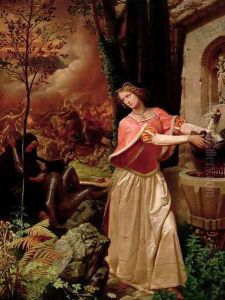William Cave Thomas Paintings
William Cave Thomas was a British artist born in 1829 in Bristol, England. He was primarily known for his career as a sculptor but was also skilled in painting and drawing. Cave Thomas showed an early interest in the arts and was apprenticed to a wood carver and gilder, which provided him with a strong foundation in the craft of sculpture. He eventually moved to London to further his education and career.
In London, Cave Thomas studied at the Royal Academy Schools, which was a significant institution for art education in Britain. During his time at the Academy, he developed his sculptural techniques and began to establish himself as an artist. He exhibited at the Royal Academy from the mid-1850s onwards, and his works were well-received by the public and critics alike.
Cave Thomas was a versatile artist, creating portrait busts, statues, and relief sculptures. His materials of choice included marble, bronze, and terracotta. He often drew inspiration from classical antiquity, mythology, and the Renaissance, which were popular sources of subject matter among Victorian artists. Some of his works were commissioned for public spaces and institutions, which helped to enhance his reputation.
Despite his success as a sculptor, William Cave Thomas also painted and was proficient in watercolors and oils. His paintings often depicted historical and mythological scenes, complementing his sculptural work. Throughout his career, Cave Thomas tried to balance the demands of public commissions with his own artistic interests.
William Cave Thomas's contributions to British art were recognized in his lifetime, and he was a respected member of the artistic community. He passed away in 1911, leaving behind a body of work that reflects the Victorian era's fascination with classical themes and the technical mastery of sculpture. His works can still be seen in various collections and public spaces, serving as a testament to his skill and artistic vision.
